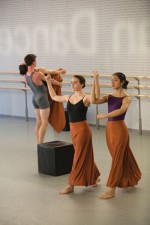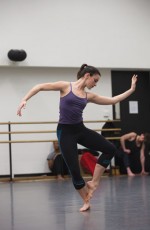Title
Subhead

From left: Sean Howe, Joseph Davis, and Joshua Guillemot-Rodgerson in an early rehearsal for Dark Meadow by former faculty member Martha Graham.
(Photo by Rosalie O'Connor) More Photos »Juilliard dancers—and the Juilliard production team—love a good challenge. For the 2015 Juilliard Dances Repertory concerts, Lawrence Rhodes, artistic director of the Dance Division, selected two masterworks of 20th-century repertory that would provide just that: Dark Meadow by Martha Graham and BIPED by Merce Cunningham. Both require extraordinary physical control, an exacting quality of movement, and maturity of intention, not just by select soloists but by their entire casts. Both also ended up requiring some fancy production footwork as well.
Body
Choreographed in 1946 by Martha Graham (Juilliard faculty 1951-77) to a score commissioned from the Mexican composer Carlos Chavez, Dark Meadow is unusual for Graham in the abstractness of its narrative. Faculty member Terese Capucilli, a longtime Graham dancer, is staging it here. The piece, she told The Journal, touches upon ideas of "death and rebirth, the elements, the cyclical feeling of the seasons and how that relates to each character." There are two female figures—The One Who Seeks, originally danced by Graham herself, and She of the Ground—plus a male figure, He Who Summons, and a danced chorus, They Who Dance Together. Sculptor Isamu Noguchi, who frequently collaborated with Graham, created the sculptural forms that are climbed upon, caressed, and manipulated during the course of the dance. But more about those later.
To create his 1999 piece BIPED, Merce Cunningham, ever the innovator, used the computer software DanceForms, which he helped to create, to develop movement vocabulary before setting the movements on his dancers. Three Cunningham company dancers were used to motion-capture 70 choreographed phrases that were then animated by decor designers Paul Kaiser and Shelley Eshkar. These animations will be projected on a scrim in front of the dancers during the performance, adding to the volume of movement danced live on stage. This layering of live and recorded performance is also reflected in the music. The score, by English composer Gavin Bryars, will be played live on acoustic instruments alongside a recorded electronic score.
Among the many challenges the two dances present are their length—upward of 40 minutes each, which is partly why there are only two dances this spring instead of the usual three—and complexity. In planning the program, Rhodes felt that the 58 dancers in this concert have the physical ability and maturity to master the two dances, though they had to start rehearsing earlier than usual. Dark Meadow in particular has extended solos that must be mastered not only physically but also with a depth of sensation that takes time for a dancer to develop.
Capucilli first danced the role of The One Who Seeks in 1989, after years of performing They Who Dance Together in Graham's company. She was able to study Dark Meadow "like a work of art," she said, observing the artistic nuances of generations of dancers in rehearsal and performance before taking on the role herself. Since the initial rehearsal in January was the first exposure to Dark Meadow for most of the cast, Capucilli sends cast members daily digests with Graham quotes and facts to help them better understand the work.
But some of the work began earlier. Since Cunningham style is not generally taught to Juilliard dancers until their third year of training, this year's second-year class took an introductory Cunningham seminar in the fall with Jennifer Goggans, who's staging the work with Juilliard Cunningham teacher Jean Freebury—both danced the piece as members of his company. When Cunningham made this piece, in 1996, he set and taught the choreography of the legs, the arms, and torso separately. In most dance styles, the movements of the arms are choreographed to aid the action of the torso and legs and to complete the overall shape. With legs and arms choreographed separately, the movement in BIPED might feel to a dancer like patting your head and rubbing your stomach at the same time, or, rather, patting your head and rubbing your stomach in an irregular rhythm while balancing on one leg, with your other leg somewhere near your ear.
In any Juilliard dance repertory concert, there are challenges for the production staff in mounting the work of artists with differing traditions and aesthetic sensibilities. But there were some unique complications in remounting these two dances. For BIPED, one was in the costumes—unitards designed by Susanne Gallo, each of which has a different shape, and all of which have a particular shine, like an oil slick, that plays with the lighting plan. Typically, the costumes for the spring dance program are rented from previous productions and supplemented by a few new costumes from Juilliard's costume shop, but because after Cunningham died, in 2009, the BIPED costumes were donated to the Walker Art Center in Minneapolis as works of art, they became off-limits for use in performance. To complicate things further, the delicate fabric, with tiny metallic medallions adhered to spandex, is no longer produced. Keith Michael, the Dance Division's production coordinator, is charged with making all the elements of the production come together in a way that satisfies both the integrity of the choreographer's vision and Juilliard's budget; he told The Journal that after "auditioning" fabrics for months, one was specially ordered to be manufactured in South Korea—and then sent here, so the unitards could be made.
In the case of Dark Meadow, the Noguchi sets had been preserved since the premiere. Unfortunately, they'd been stored at the Martha Graham Center for Contemporary Dance, in Greenwich Village, and they were damaged by Hurricane Sandy flooding. As a result, they had to be refurbished and reconstructed by the Juilliard scene shop, matching paint colors exactly for the original pieces and replacing missing props. No documentation was found to describe the dimensions of the missing pieces, so Capucilli and Michael had to experiment with prototypes until the best approximation of the original was found. The company's costumes were also damaged by the flood and had to be made by the Juilliard costume shop— costumes for both works will be given to the respective companies once the Juilliard performances are over.
In the Cunningham tradition, musicians are seen; in Graham tradition, they are not. Where will the depth of Juilliard's orchestra pit be set for the evening? A solution will be found before Aaron Sherber, the music director of the Martha Graham Dance Company, takes up the baton to conduct the Juilliard Orchestra in Dark Meadow. With so much effort and talent behind the curtain, the audience will no doubt enjoy the two masterworks on stage and think nothing of the challenges that led to the curtain opening.









